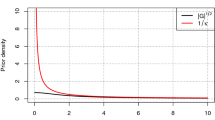Abstract
In the framework of a robustness study on maximum likelihood estimation with LISREL three types of problems are dealt with: nonconvergence, improper solutions, and choice of starting values. The purpose of the paper is to illustrate why and to what extent these problems are of importance for users of LISREL. The ways in which these issues may affect the design and conclusions of robustness research is also discussed.
Similar content being viewed by others
References
Anderson, J. C., & Gerbing, D. W. (1984). The effect of sampling error on convergence, improper solutions, and goodness-of-fit indices for maximum likelihood confirmatory factor analysis.Psychometrika, 49, 155–173.
Bentler, P. M., & Tanaka, J. S. (1983). Problems with EM algorithms for ML factor analysis.Psychometrika, 48, 247–251.
Boomsma, A. (1982). The robustness of LISREL against small sample sizes in factor analysis models. In K. G. Jöreskog & H. Wold (Eds.),Systems under indirect observation: causality, structure, prediction (Part 1, pp. 149–173). Amsterdam: North-Holland.
Boomsma, A. (1983).On the robustness of LISREL (maximum likelihood estimation) against small sample size and non-normality. Unpublished doctoral dissertation, University of Groningen, Groningen.
Gruvaeus, G. T., & Jöreskog, K. G. (1970).A computer program for minimizing a function of several variables (Research Bulletin 70-14). Princeton, NJ: Educational Testing Service.
Hägglund, G. (1982). Factor analysis by instrumental variable methods.Psychometrika, 47, 209–222.
IMSL (1982).IMSL Library. Reference Manual. (Vol. 2, 9th ed.). Houston, TX: International Mathematical and Statistical Libraries.
Jöreskog, K. G. (1967). Some contributions to maximum likelihood factor analysis.Psychometrika, 32, 443–482.
Jöreskog, K. G. (1977). Structural equation models in the social sciences: Specification, estimation, testing. In P.R. Krishnaiah (Ed.),Applications of statistics (pp. 265–287). Amsterdam: North-Holland.
Jöreskog, K. G., & Sörbom, D. (1981).LISREL V. Analysis of linear structural relationships by maximum likelihood and least squares methods (Research Report 81-8). Uppsala: University of Uppsala, Department of Statistics.
Jöreskog, K. G., & Sörbom, D. (1984).LISREL VI. Analysis of linear structural relationships by maximum likelihood, instrumental variables, and least squares methods. User's guide. Uppsala: University of Uppsala, Department of Statistics.
Kelderman, H. (in press). LISREL models for inequality constraints in factor and regression analysis. In P. F. Cuttance & J. R. Ecob (Eds.),Structural modeling. Cambridge: Cambridge University Press.
Lee, S. Y. (1980). Estimation of covariance structure models with parameters subject to functional restraints.Psychometrika, 45, 309–324.
Mattson, A., Olsson, U., & Rosèn, M. (1966).The maximum likelihood method in factor analysis with special consideration to the problem of improper solutions (Research Report). Uppsala: University of Uppsala, Department of Statistics.
Rindskopf, D. (1983). Parameterizing inequality constraints on unique variances in linear structural models.Psychometrika, 48, 73–83.
Rindskopf, D. (1984). Using phantom and imaginary latent variables to parameterize constraints in linear structural models.Psychometrika, 49, 37–47.
Rubin, D. B., & Thayer, D. T. (1982). EM algorithms for ML factor analysis.Psychometrika, 47, 69–76.
Rubin, D. B., & Thayer, D. T. (1983). More on EM for ML factor analysis.Psychometrika, 48, 253–257.
Tamura, Y., & Fukutomi, K. (1970). On the improper solutions in factor analysis.TRU Mathematics, 6, 63–71.
Van Driel, O. P. (1978). On various causes of improper solutions in maximum likelihood factor analysis.Psychometrika, 43, 225–243.
Author information
Authors and Affiliations
Rights and permissions
About this article
Cite this article
Boomsma, A. Nonconvergence, improper solutions, and starting values in lisrel maximum likelihood estimation. Psychometrika 50, 229–242 (1985). https://doi.org/10.1007/BF02294248
Received:
Revised:
Issue Date:
DOI: https://doi.org/10.1007/BF02294248




